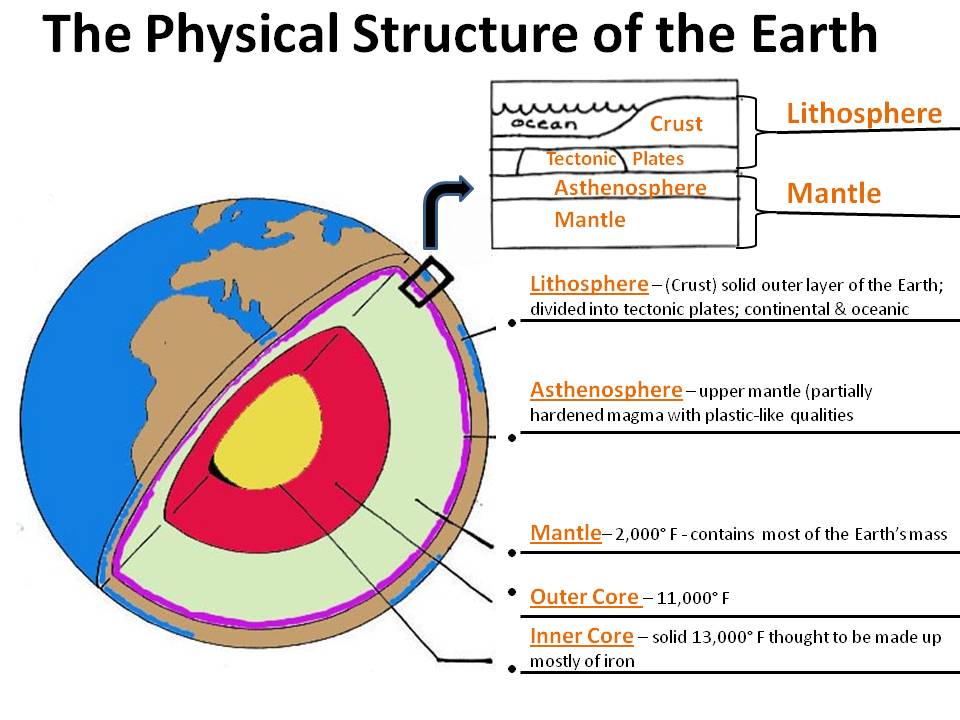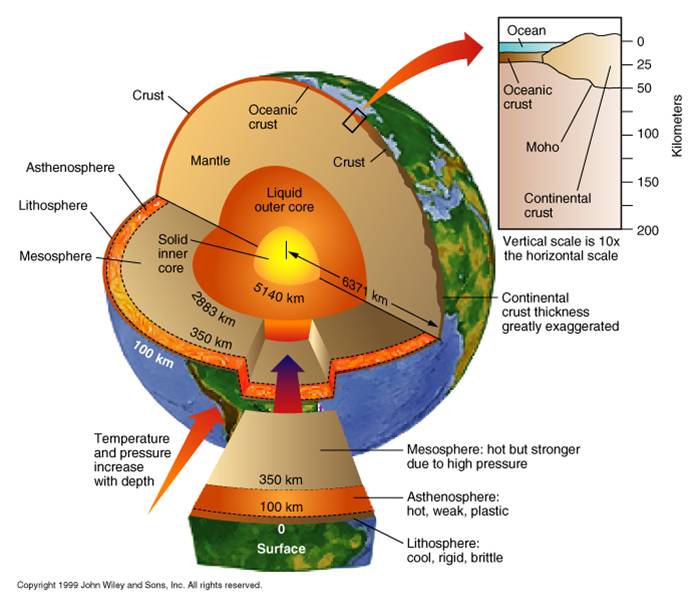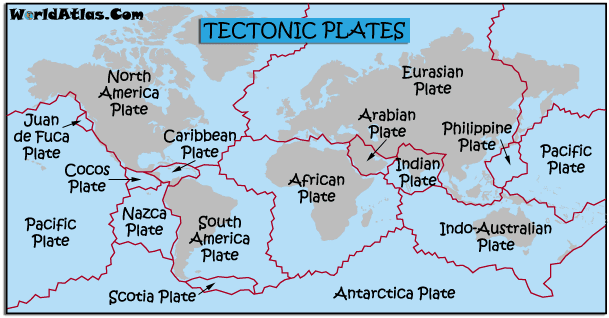

 http://www.enchantedlearning.com/subjects/astronomy/planets/earth/Continents.shtml
http://www.enchantedlearning.com/subjects/astronomy/planets/earth/Continents.shtml

Video on plate tectonics, that we saw in class.
http://www.watchknowlearn.org/Video.aspx?VideoID=55291



Names of the tectonic plates



Ms Helms page
http://www.livebinders.com/play/play?id=2034236
Study Page
http://mcdowellscienceexam.weebly.com/lithosphere.html
Geography4kids
http://www.geography4kids.com/files/earth_intro.html
Printable worksheets
http://printableworksheets.in/worksheet/volcanoes-and-earthquakes
http://www.coolgeography.co.uk/GCSE/AQA/Restless%20Earth/Tectonics/Plate%20Tectonics.htm
6.E.2 Understand the structure of the earth and how interactions of constructive and destructive forces have resulted in changes in the surface of the Earth over time and the effects of the lithosphere on humans.
6.E.2.1 Summarize the structure of the earth, including the layers, the mantle and core based on the relative position, composition and density.
6.E.2.1 The earth is composed – primarily- of rock. Three-fourths of the earth’s surface is covered by a relatively thin layer of water (some of it frozen), and the entire planet is surrounded by a relatively thin layer of gas we call the atmosphere. The Earth has a solid inner core that is surrounded by a liquid outer core. The inner core is a solid section of the Earth and is unattached to the mantle, being suspended by the molten outer core. The inner core is predominantly iron metal with significant amounts of the element nickel. This inner layer in mutual combination with the rotational motion of the Earth creates a dynamo effect where a force field is generated. This field is also known as Earth’s magnetic field. In terms of the physical aspects of the outer core, the layer is dense but not as dense as pure molten iron. Surrounding the entire dense, metallic core is a thick, hot, convective layer called the mantle. The crust consists of many continental and oceanic plates that have slowly moved and changed positions on the globe throughout geologic time.
6.E.2.2 Explain how crustal plates and ocean basins are formed, move and interact using earthquakes, heat flow and volcanoes to reflect forces within the earth.
6.E.2.2 The earth's plates sit on a dense, hot, somewhat melted layer of the earth. The plates move very slowly, pressing against one another in some places and pulling apart in other places, sometimes scraping alongside each other as they do. Mountains form as two continental plates, or an ocean plate and a continental plate, press together. There are worldwide patterns to major geological events (such as earthquakes, volcanic eruptions, and mountain building) that coincide with plate boundaries. Lithospheric plates on the scale of continents and oceans constantly move at rates of centimeters per year as a result of movements in the mantle coupled with characteristics of the plates themselves. Major geological events, such as earthquakes, volcanic eruptions, and mountain building, result from these plate motions. The crustal plates range in thickness from a few to more than 100 kilometers. Ocean floors are the tops of thin oceanic plates that spread outward from mid-ocean rift zones; land surfaces are the tops of thicker, less-dense continental plates. Earth is made up of 4 different layers: inner core, outer core, mantle, crust. Seismologists have studied how wave energy travels through the different layers of Earth. Waves have characteristics: frequency, wavelength, amplitude and speed. During an earthquake, energy is released into the Earth as: Primary waves, Secondary waves and Surface waves.
Part 1 The Layers of the Earth
Earth’s System & Structures 6.E.2 Unit Planning Document
End of 2nd-3rd-4th Quarter
|
Earth Systems, Structures and Processes (Plate Tectonics and Seismic Waves)
|
|
67
|
1/23/19
|
Unit E
6.E.2.1
|
Earth’s Layers
I can... identify Earth’s layers on a diagram.
I can ....identify and label or illustrate a model of the layers of the earth.
Vocabulary List
I
https://sciencewithmsbarton.files.wordpress.com/2013/10/beneath-our-feet-earths-layers-basic-reading-questions.pdf
https://sciencewithmsbarton.wordpress.com/tag/plate-tectonics/
Lithosphere and plates
https://mcdowellscienceexam.weebly.com/lithosphere.html
rap song
https://www.youtube.com/watch?v=HOd7PRJMkkQ
|
Earth's Layers PPT
Beneath Our Feet: The Four Layers of Earth Worksheet
Earth's Layers Rap Song
Earth's Layers Interactive Video Discovery Ed
Structure of the Earth Exploration
Earth's Composition Integrated Reading
Bill Nye Earth's Crust
Bill Nye Video Earth's Crust Video Review Worksheet
Earth's Layers Interactive
|
|
68
|
1/26/19
|
Unit E
6.E.2.1
|
Earth’s Layers
I can draw a model of Earth’s layers and explain the characteristics of each.
|
Earth's Layers Foldable
Earth’s Layers Leveled Reader
Video: Earth’s Interior and Plate Tectonics
|
|
69
|
1/28/19
|
Unit E
6.E.2.1
6.E.2.2
|
Earth’s Plates
I can understand the Theory of Plate Tectonics.
https://projects.ncsu.edu/labwrite/res/middle/quake-worksheet.htm
Plate Tectonics and Earth's Structure
vocabulary online book
https://docs.google.com/file/d/0B66OKgyJ8ekfQkZIOGd6S1U5aWM/edit
|
Plate Tectonics PPT
Plate Tectonics (eTextbook)
Plate Tectonics and Earth’s Structure (eTextbook)
CK-12: Earth’s Tectonic Plates
Plate Tectonics Video
Interactive: Plates and Boundaries
|
|
70
|
1/28/19
|
Unit E
6.E.2.1
6.E.2.2
|
Movement of Earth’s Plates
I can explain how crustal plates move.
Tectonics of the Planet Earth [educational video]
https://www.youtube.com/watch?v=Kg_UBLFUpYQ
This is the simulation we saw in class.....................................
|
CK-12: Theory of Plate Tectonics
Forces Shaping the Earth (eTextbook)
Plate Tectonics Simulation
Brain Pop plates
https://www.youtube.com/watch?v=RA2-Vc4PIOY
|
|
71
|
1/28/19
|
Unit E
6.E.2.1
6.E.2.2
|
Pangaea
I can communicate with others about Pangaea.
Google Earth
https://earth.google.com/web/@-13.72310514,-11.98272653,-9055.6272905a,11425745.34404039d,35y,1.43163389h,0t,0r
|
Pangaea Begins to Break Apart
Common Core Reading About Pangaea
USGS World Map and Pangaea Puzzle
Wegener Article
|
|
72
|
1/29/18
|
Unit E
6.E.2.1
6.E.2.2
|
Earth’s Layers
I can demonstrate how Earth’s Layers impact how plates move.
https://www.smithsonianmag.com/science-nature/dinosaur-killing-asteroid-impact-chicxulub-crater-timeline-destruction-180973075/
|
Grade 6 Science Earth's Layers/Plates
Flocabulary- Earth's Layers/Plate Tectonics
Plate Tectonics (online quiz)
|
|
73
|
1/29/19
|
Unit E
6.E.2.1
6.E.2.2
6.P.1.1
|
Primary / Secondary / Surface Waves
I can describe the characteristics of primary, secondary and surface waves.
Stop here until this section is complete.
|
Earthquake Glossary - Seismic Waves
Seismic Waves Video Clip
Seismic Waves Diagram
Seismology Video
|
|
74
|
1/30/19
|
Unit E
6.E.2.1
6.E.2.2
6.P.1.1
|
EarthQuakes
Primary / Secondary / Surface Waves
How are Seismic Waves Detected
I can..... describe the characteristics of primary, secondary and surface waves and how they are detected.
|
Earthquakes & Volcanoes PPT
CK-12: Seismic Waves From Earthquakes
CK-12: Measuring Earthquake Magnitude
Earthquakes Article / Activity
IRIS Article - How Are Earthquakes Located?
IRIS Article: Watch Earthquakes as they Occur - The Seismic Monitor
IRIS Article - Exploring the Earth Using Seismology
IRIS Article - How Does a Seismometer Work?
P and S Waves Moving Through Earth's Interior
|
|
75
|
1/30/19
|
Unit E
6.E.2.1
6.E.2.2
|
Earthquakes
I can explain how earthquakes create seismic waves.
OR
I can explain what causes an earthquake to occur.
tsunami soo4
https://www.youtube.com/watch?v=3O0cLjTev9c
National Geographic Natural Disasters
https://www.nationalgeographic.com/environment/natural-disasters-weather/?section=v
|
The Science of Earthquakes
Earthquakes (eTextbook)
What Causes Earthquakes?
Earthquake Waves Animations
Earthquake Epicenter Interactive
Anatomy of an Earthquake
Earthquake in Seattle Video
|
|
76
|
1/30/19
|
Unit E
6.E.2.1
6.E.2.2
|
Volcanoes
I can explain what causes a volcano to occur.
Mt St Helens usa
https://www.youtube.com/watch?v=AYla6q3is6w
https://www.youtube.com/watch?v=sm-EvazNCjU
|
Build Your Own Volcano
national geo
CK-12: Volcano Characteristics
CK-12: Volcanoes at Plate Boundaries
“It’s Going To Blow Up”
Volcanoes (eTextbook)
Study Jams: Volcanoes
NOVA Clip: Meet the Volcanoes
Volcano Facts
Volcano Virtual Lab
Online Volcano Simulation
|
|
77
|
1/30/19
|
Unit E
6.E.2.1
6.E.2.2
|
Earthquakes / Volcanoes / The Ring of Fire
I can explain how the Ring of Fire relates to other geological events (such as earthquakes, volcanoes, and seismic activity).
|
Video Clip Earthquakes on the Pacific Ring of Fire
How the Earth was made: Ring of Fire Video
Ring of Fire Leveled Reader
|
|
78
|
1/30/19
|
Unit E
6.E.2.1
6.E.2.2
|
Earthquakes and Volcanoes
CFA Seismic Waves / Earthquakes / Volcanoes
I can explain how seismic activity influences earthquakes and volcanoes.
|
Grade 6 Science Seismic Waves / Earthquakes / Volcanoes
Earthquakes and Volcanoes Virtual Lab
Secrets of the Earth's Crust Integrated Reading
"Volcano Lite" Integrated Reading Passage
|
|
2/21/19
|
|
Plate Tectonics and Earth's Structure
https://www.iss.k12.nc.us/cms/lib4/NC01000579/Centricity/Domain/2016/006%20Plate%20Tectonics%20and%20ES.pdf
|
|
|
|
|
Review and Research Sites
Plate Tectonics Quizlet
https://quizlet.com/_34mf47
Interactive Earth's Structure
http://www.learner.org/interactives/dynamicearth/structure.html
Mountain Maker, Earth Shaker
http://www.pbslearningmedia.org/asset/ess05_int_shake/
Examining P and S waves through Earth's interior
http://www.classzone.com/books/earth_science/terc/content/visualizations/es1009/es1009page01.cfm?chapter_no=visualization
Seismic Waves From Earthquakes
http://www.ck12.org/book/CK-12-Earth-Science-Concepts-For-Middle-School/r19/section/5.11/
Measuring Earthquake Magnitude
http://www.ck12.org/book/CK-12-Earth-Science-Concepts-For-Middle-School/r19/section/5.14/
Volcano Characteristics
http://www.ck12.org/book/CK-12-Earth-Science-Concepts-For-Middle-School/r19/section/5.20/
Volcanoes at Plate Boundaries
http://www.ck12.org/book/CK-12-Earth-Science-Concepts-For-Middle-School/r19/section/5.21/
How Plates Affect Our Planet: Volcanoes
/media/get/MTU0NDkyMjA=
Volcanoes: Magma Rising- Volcanic Eruptions
/media/get/MTU0NDkyNDQ=
Volcanoes: Magma Rising- Studying Volcanoes
/media/get/MTU0NDkyNjI=
Earth Layers & Plate Tectonics Study Guide
https://docs.google.com/document/d/1QcCZzI_ulEPDlxt4C_OnRyhH8Zx0eSqzCLWktf9KgXY/edit?usp=sharing
Test- GOOD LUCK :)
https://docs.google.com/document/d/1kVxk6H7Zr5Nd-_v_uMifdrh-iNbeIrh-BEql3cXQcqE/edit?usp=sharing
|
|
|
79
|
1/4/16
|
Unit E
6.E.2.1
6.E.2.2
6.P.1.1
|
Review Unit E: Plate Tectonics and Seismic Waves
I can illustrate the various types of seismic waves and how they influence plate movement or geological events.
|
Movement of Continental Plates Interactive
Grade 6 Science Earth’s Layers / Plates Study Guide
|
|
80
|
1/5/16
|
Unit E
6.E.2.1
6.E.2.2
6.P.1.1
|
Unit E Test: Plate Tectonics and Seismic Waves
I can illustrate the various types of seismic waves and how they influence plate movement or geological events.
|
Grade 6 Science Test Plate Tectonics and Seismic Waves
|
Comments (0)
You don't have permission to comment on this page.